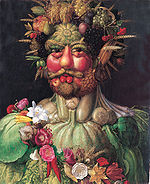At least one character's name in 2666 has a deeper meaning than what appears on the surface. Who was Arcimboldo?
Vertumnus, Rudolph II Holy, Roman Emperor painted as the Roman God of the Seasons, 1590.
So why pick a Surrealist painter to pay homage to? It is a deliberate writing choice by Bolano to have one of his main characters change his last name from Reiter to a deviated version of Arcimboldo ( Reiter changes his name to Archimboldi).
On one level, the now dead Bolano gives us a wink when he uses Arcimboldo, suggesting that 2666 is surreal, not only in the many dreams and visions in the novel, but how we can read the novel like a dream. And, on another level, Bolano may be giving us insight into the nature of what we take from novels ( or any story telling device, even dreams). Rieter takes ideas from a notebook he finds and reads, such as this painter's name, and absorbs these ideas into his own life after altering them.
More about Arcimboldo
Although unrecognized as a great artist for many years since his death, the surrealists Dali and Magritte claimed Arcimboldo as one of their own, creating a place for him in art history. Man Ray recreated Arcimboldo's "Winter" and Alfred Barr, the founding director of the Museum of Modern Art, included Archimboldo in a 1936 show called "Fantasy in Art, Dada and Surrealism."
Arcimboldo's Winter
Man Ray was inspired by this painting (Seen below)
Magritte and Dali used objects for body parts, as seen here in a Magritte Suurealistic painting
Arcimboldo lived at a time when visual puns were highly regarded. The Surrealist-type paintings of Arcimbaldo show 16th century tastes: naturalism and the grotesque, as in the reversible paintings that are still-life that become faces when the panels are flipped upside down.
daVinci, Michelangelo and others like to make cartoon-like grotesques. Here we see da Vinci's drawing. Arcimboldo saw da Vinci's drawings.
drawing of Arcimboldo
See a slide show of Arcimboldo's work here: http://www.nytimes.com/slideshow/2007/10/09/arts/20071010_ARCI_SLIDESHOW_index.html?ref=design
Sources: http://www.nytimes.com/2010/09/24/arts/design/24arcimboldo.html







No comments:
Post a Comment